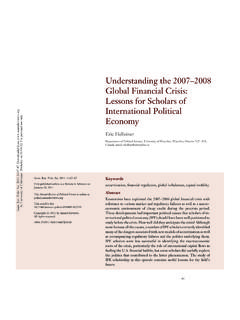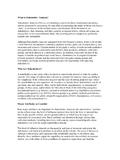Transcription of T POLITICAL ECONOMY OF WAR AND EACE - …
1 THE POLITICAL ECONOMY OF WAR AND PEACE. Christopher J. Coyne and Adam Pellillo . Abstract From a POLITICAL ECONOMY perspective, in order for conflict to occur, one (or more) POLITICAL actor(s) must expect that the benefits of entering into conflict ( improved security, POLITICAL , social, or economic outcomes) exceed the costs. Understanding why this calculus would tip in favor of conflict is the central question in the study of the POLITICAL ECONOMY of war and peace. This survey explores some of the institutional and POLITICAL factors that set the underlying conditions for the emergence of conflict. The POLITICAL ECONOMY perspective offered here differs from other important surveys and analyses of the same topic, which have focused on the ethnic dimensions of war (Horowitz 1985), the general causes and consequences of civil war and civil conflict (Sambanis 2002; Collier and Hoeffler, 2007; Blattman and Miguel 2010), and more general aspects of defense economics (Sandler and Hartley 2007).
2 Christopher J. Coyne Department of Economics, MSN 3G4 George Mason University, Fairfax, VA, 20020 and Adam Pellillo Department of Economics, West Virginia University, PO Box 6025, Morgantown, WV 26506-6025. 1. 1. Introduction Violent conflict is extraordinarily costly. Causing immense human suffering, loss of life, internal displacement, and destruction of resources, war is effectively development in reverse' (Collier et al. 2003). Given its social welfare consequences, the emergence of conflict should be seen as a puzzle to many observers. Yet from a POLITICAL ECONOMY perspective, in order for conflict to occur, one (or more) POLITICAL actor(s) must expect that the benefits of entering into conflict ( improved security, POLITICAL , social, or economic outcomes) exceed the costs.
3 Understanding why this calculus would tip in favor of conflict is the central question in the study of the POLITICAL ECONOMY of war and peace. Analyzing the logic of POLITICAL violence requires the tools of public choice economics. By highlighting the incentives, opportunities, and constraints facing different POLITICAL actors ( leaders, rebels, military officers, insurgents, terrorists, diplomats, and even the occasional firm1), we can understand why conflict This approach to understanding war and peace places primary emphasis on the roles of constitutions, governance, legal systems, and bureaucracies since these institutional factors influence the incentives, opportunities, and constraints that POLITICAL actors face. For instance, we consider why weak and ineffective POLITICAL institutions may not provide binding constraints on the declaration of war or may insufficiently protect private property rights from expropriation.
4 Further, weak legal 1. Guidolin and La Ferrara (2007), for instance, find that the death of Jonas Savimbi, the UNITA rebel group leader in Angola, led to a decline in stock market returns among mining companies holding concessions in that country. They conclude that moderate levels of civil conflict can actually be financially beneficial for a handful of firms whose profitability is determined by the prolonging of conflict. This illustrates that some investors or companies may turn a blind eye to conflict given its profitability. 2. As described by Acemoglu (2003, p. 621), under a theory of social conflict, societies choose different policies, some of which are disastrous for their citizens, because those decisions are made by politicians or politically powerful social groups that are interested in maximizing their own payoffs, not aggregate output or social welfare.
5 Tullock (2005: 312) argued that it is clear that an extremely bloody and destructive war and, looked at from the standpoint of the entire citizenry of the two countries, undesirable. Looked at from the standpoint of the dictator, however, it has a positive discounted value.. 2. institutions may preclude the resolution of disputes through legitimate means or may not impartially enforce contracts. Poor POLITICAL institutions (or bad governance') can further hamper the ability of POLITICAL actors to credibly commit to peace negotiations, providing a rationalist explanation for the emergence of conflict (Fearon 1995). Weakly institutional polities may not lead the true social costs of conflict to be internalized in the decision making calculus of POLITICAL leaders.
6 These factors set the underlying structural conditions that provide opportunities for expropriation and conflict. While we cannot comprehensively assess all of the proximate causes of conflict in this chapter, our hope is to shed light on some of the institutional and POLITICAL factors that set the underlying conditions for the emergence of This POLITICAL ECONOMY perspective differs from other important surveys and analyses of the same topic, which have focused on the ethnic dimensions of war (Horowitz 1985), the general causes and consequences of civil war and civil conflict (Sambanis 2002; Collier and Hoeffler, 2007; Blattman and Miguel 2010), and more general aspects of defense economics (Sandler and Hartley 2007). Together, these surveys should help to illustrate the complexities of conflict while at the same time contributing to our understanding of its underlying causes.
7 3. We are cognizant that there are multiple factors not discussed in this chapter that are central to understanding war or peace. For instance, we exclude factors such as ethnolinguistic fractionalization (or polarization), the trade in small-arms, post-conflict economic reconstruction, the role of geography ( , terrain, natural resources, commodities, such as diamonds or cocaine, that fund rebels groups) that influence the onset, duration, and recurrence of conflict, as well as the industrial organization of terrorist, insurgent, and rebel groups, the influence of ideology or behavioral factors on the decision making of POLITICAL actors. Our exclusion of these factors is not intended to downplay the importance of them for understanding conflict and peace.
8 Instead, our central focus is on the institutions and POLITICAL elements which influence the costs and benefits associated with these various factors. For instance, adverse geography and rough terrain can challenge the ability of states to establish monopolies on the legitimate use of force (see Acemoglu, Robinson, and Santos 2010). Likewise, natural resource rents could induce agents to choose to appropriate others' property rather than to engage in productive behavior. 3. We proceed as follows. The next section briefly assesses the economic approach to conflict. We focus on different types of conflict and summarize the existing literature's approaches to conflict analysis. Section 3 discusses the importance of institutions for understanding conflict.
9 After defining the relevant institutions, we explore the variety of channels through which institutions may influence war or peace. Most of the analysis in these sections focuses on intra-state conflict, given that this has become the dominant form of conflict in recent years (see Harbom and Wallensteen 2010). Our focus then largely shifts to the analysis of inter-state war and peace in Section 4. We first consider democratic peace theory in Section , followed by a consideration of the capitalist peace in Section In each case we provide a discussion of the underlying theory, as well as the empirical evidence for and against each theory. Section 5 concludes with a discussion of potential avenues for future research and analysis. 2. The economic analysis of conflict Defining conflict Before discussing the POLITICAL ECONOMY of war and peace, it is instructive to define conflict' and to list the various forms of conflict that have been observed over time and across countries.
10 For our purposes, a conflict occurs when two (or more) parties resort to violence as a means of dispute resolution. Disputes can occur for a variety of reasons ( , over economic resources or opportunities; ideological, ethnic, or religious tensions; politics and borders). 4. At the meta-level of analysis, an intra-state war is defined by the Correlates of War Project as a war that is fought within state borders between a government and a non-government entity (a civil war), or, alternatively, as a war between two or more non-government forces (an inter-communal war). Intra-state wars are associated with at least 1,000 combat-related deaths in one year (Small and Singer, 1982). An inter-state war is defined as a war between two states with at least 1,000 battle-related fatalities in total in a given year.





